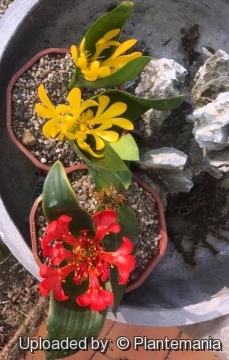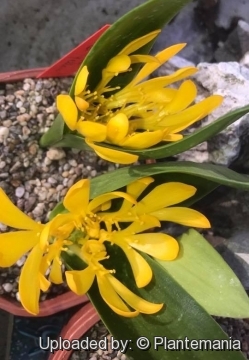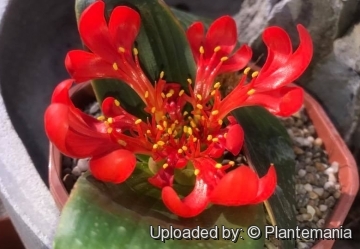Accepted Scientific Name: Daubenya aurea Lindl.
Edwards's Bot. Reg. 21: t. 1813 (1836).

Massonia aurea (Daubenya aurea) Photo by: © Plantemania
(Hyacinthaceae) It is a rare, winter-growing bulb. Its extraordinary flowers appear in spring and are instantly recognisable due to each of the outer flowers having one of its petals enlarged. It is thought that this arrangement gives the inflorescence the overall appearance of being the ray florets of a daisy - and this attracts the monkey beetles that pollinate them. The flowers are either bright red or bright yellow, the two colours occurring in separate colonies.
Origin and Habitat: Daubenya aurea is range-restricted species found only high in the Roggeveld Mountains, in suitable habitats between Sutherland and Middelpos in the Northern Cape Province of South Africa.
Altitude range: Around 500 metres above sea level.
Habitat and ecology: Fynbos, Succulent Karoo. This species grows on flat, low-lying dolerite-derived red clay soils, which can become damp during the rainy season. D. aurea is frost tolerant and is often covered by snow in its natural environment. It appears that low temperatures induce better flowering. Rapid, recent expansion of cultivation of low-lying clay flats is severely threatening this species. The species is locally abundant in suitable habitat. D. aurea is pollinated by monkey beetles. The enlarged outer petals of the flowers give the inflorescence the overall appearance of a daisy, which attract these beetles. Although it has not been identified as a negative impact, field observations indicate that plants are subjected to heavy grazing and trampling. Populations are sympatric with Daubenya marginata in several of the localities but flower much later than that species. D. aurea occurs in two colour forms, the more common one a brilliant red and the other canary yellow. Populations are typically uniformly coloured, although red populations will often contain occasional yellow morphs, whereas yellow populations may include a few plants in which the tepals are flushed reddish at the tips.
Synonyms:
See all synonyms of Daubenya aurea
back
Accepted name in llifle Database:Daubenya aurea Lindl.Edwards's Bot. Reg. 21: t. 1813 (1836).Synonymy: 6
back
Common Names include:
ENGLISH: Jewels of the desert
Description: Daubenya aureaSN|33674]]SN|33674]] is a flat-growing, bulbous geophyte up to 50 mm tall. It produces two spreading leaves up to 110 mm long and 60 mm wide, which are ovate and narrowing to a broad tip. The tubular flowers are produced in a low aggregate cluster between the two leaves and are of a fine golden yellow colour, orange or red, and nearly sessile. Outer flowers are irregular with three sub-equal spoon-shaped segments longer than the tube and three small spear-shaped inner segments. Whilst, the outer perianth segments are longer than the stamens, the stamens are longer than the inner flowers.
Derivation of specific name: The specific epithet, aureus, refers to the golden yellow flowering form of this species.
Bulb: 2-3.5 cm in diameter, usually deeply buried in the ground. Outer tunics leathery, dark brown, extending in a short, papery neck up to 1 cm long.
Leaves: 2, thin, rather fleshy, dark green ovate, oblong, or lanceolate, suberect to spreading, glabrous, 5-11(-14) cm long, 2-7.5 cm broad, many-ribbed, bases clasping peduncle for 5-50 mm.
Inflorescence: The inflorescence is a corymbose capitulum ( looking like a large flower in the genus Arctotis or Gazaniadue to the enlargement of the lower florets) about 7.5 cm in diameter held on a short peduncle up to 50 mm above the two leaves. Outer bracts several, large, greenish, oblong, membranous. Pedicels suberect, lowermost 5-10 long, uppermost up to 3 mm long.
Flowers: Bright yellow, orange or red, rarely flushed reddish at tips of tepals, more or less zygomorphic and bilabiate. Outer flowers zygomorphic very irregular, with three subequal oblong-spathulate segments longer than the tube and three small lanceolate inner segments; stamens half as long as the outer segments. Inner (upper) flowers weakly zygomorphic or actinomorphic with all the segments linear and shorter than the stamens. The flowers, unlike those of the other species in the genus, do not produce nectar and are also unscented or at most weakly
Blooming season: Daubenya aureaSN|33674]]SN|33674]] flowers in spring, mainly in late August to mid September, but has also been recorded flowering in July and August. The yellow populations consistently come into flower one or two weeks before the red but the fruits appear to take much longer to ripen.
Fruit (capsule): Oblong-ovoid, 3-angled, 15-20 x 7-10 mm, acute at apex. The prominent papery bracts that are characteristic of the species are particularly conspicuous in fruit, serving as sails that assist in the wind dispersal of the infructescences.
Seeds: Globular, rarely slightly ellipsoidal, c. 3 mm in diameter, glossy black.
Chromosome number: 2n = 32.
Subspecies, varieties, forms and cultivars of plants belonging to the Daubenya aurea group
 Daubenya aurea Lindl.: Produces a cluster of nearly sessile yellow, orange or red flowers between the two leaves. Outer flowers are irregular with three spoon-shaped segments. Distribution: Roggeveld Mountains, between Sutherland and Middelpos, N Cape, South Africa.
Daubenya aurea Lindl.: Produces a cluster of nearly sessile yellow, orange or red flowers between the two leaves. Outer flowers are irregular with three spoon-shaped segments. Distribution: Roggeveld Mountains, between Sutherland and Middelpos, N Cape, South Africa.  Daubenya aurea var. coccinea (Harv. ex Baker) Marloth: same as the type but with bright red flowers. Distribution: Roggeveld Mountains, between Sutherland and Middelpos, N Cape, South Africa.
Daubenya aurea var. coccinea (Harv. ex Baker) Marloth: same as the type but with bright red flowers. Distribution: Roggeveld Mountains, between Sutherland and Middelpos, N Cape, South Africa.
Bibliography: Major references and further lectures
1) J. G. Baker “Flora Capensis” 1897
2) Baloyi Cynthia Mikateko & Marinda Koekemoer Pretoria National Herbarium January 2014 “Daubenya aurea” in: Plantzafrica - <https://www.plantzafrica.com/plantcd/daubenyaaurea.htm> Web. 6 January 2017
3) Hall, H. 1970. “Daubenya Lindley: a rare, monotypic, little-known genus of Liliaceae.” Journal of South African Botany 56:13-16.
4) Manning, J.C. and Van der Merwe, A.M. 2002. “Systematics of the genus Daubenya (Hyacinthaceae: Massonieae)”. Bothalia 32(2):133-150.
5) Phillips, E.P. 1922. “Daubenya aurea var coccinea”. Flowering Plants of Africa 2:t.71.
6) G.D. & von Staden, L. 2010. Daubenya aurea Lindl. National Assessment: Red List of South African Plants version 2015.1. Accessed on 2017/02/06
7) “Floricultural Cabinet and Florist's Magazine” 1835
8) John Lindley “Edwards's Botanical Register” 1839
9) Wolfgang Wetschnig and Martin Pfosser “The Scilla plumbea Puzzle-Present Status of the Genus Scilla Sensu Lato in Southern Africa and Description of Spetaea lachenaliiflora, a New Genus and Species of Massonieae (Hyacinthaceae)” Taxon Vol. 52, No. 1 (Feb., 2003), pp. 75-91 URL: http://www.jstor.org/stable/3647303
10) P. Goldblatta, J.C. Manningb, F. Forestd “A review of chromosome cytology in Hyacinthaceae subfamilies Urgineoideae and Hyacinthoideae (tribes Hyacintheae, Massonieae, Pseudoprospereae) in sub-Saharan Africa” South African Journal of Botany Volume 83, November 2012, Pages 134–144 URL http://dx.doi.org/10.1016/j.sajb.2012.07.023
11) Goldblatt, P., Bernhardt, P., Manning, J.C. 1998. “Pollination of Petaloid Geophytes by Monkey Beetles (Scarabaeidae: Rutelinae: Hopliini) in Southern Africa”. Annals of the Missouri Botanical Garden 85: 215–230 .
12) Manning, J. 2001. “South Africa's jewels of the desert: A reappraisal of the genus Daubenya (Hyacinthaceae)”. Herbertia 56: 61–66.
13) Manning, J., Goldblatt, P.E. & Snijman, D. 2002. “The colour encyclopaedia of Cape bulbs”. Timber Press, Oregon.
14) Manning, J. and Van Der MerweA.M. “Systematics of the genus Daubenya (Hyacinthaceae: Massonieae)” Bothalia 32,2: 133-150(2002)
15) Raimondo, D., Von Staden, L., Foden, W., Victor, J.E., Helme, N.A., Turner, R.C., Kamundi, D.A. & Manyama, P.A. (eds) 2009. “Red List of South African plants”. Strelitzia 25 . South African National Botanical Institute, Pretoria.
16) Van der Merwe, H. 2010. “Wild flowers of the Roggeveld and Tanqua”. Published by author.
 Daubenya aurea. Flowers are yellow in the typical form but red or orange in var. coccinea. (Daubenya aurea) Photo by: © Plantemania
Daubenya aurea. Flowers are yellow in the typical form but red or orange in var. coccinea. (Daubenya aurea) Photo by: © Plantemania Massonia aurea (Daubenya aurea) Photo by: © Plantemania
Massonia aurea (Daubenya aurea) Photo by: © Plantemania Massonia aurea (Daubenya aurea) Photo by: © Plantemania
Massonia aurea (Daubenya aurea) Photo by: © PlantemaniaSend a photo of this plant.The gallery now contains thousands of pictures, however it is possible to do even more. We are, of course, seeking photos of species not yet shown in the gallery but not only that, we are also looking for better pictures than those already present.
Read More...













